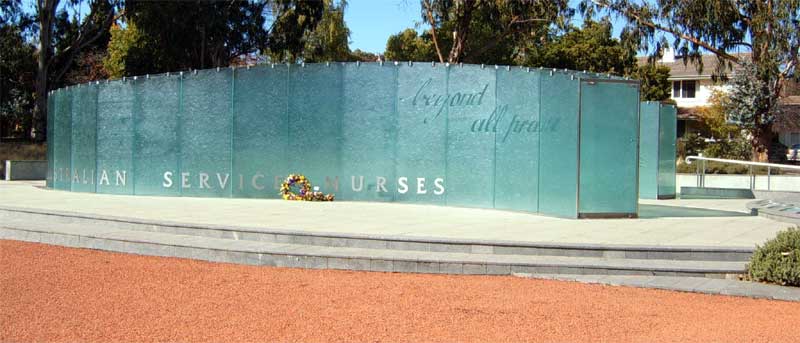This is the first in a series of blog posts commemorating ANZAC Day that will be published over the next week.
Selena Williams is a Research Assistant working on the Australian Research Council Linkage Project ‘A Land fit for Heroes’? She has recently graduated from the University of New England with a Master of Arts (Hons) on the topic of World War One nurses as soldier settlers. Prior to this Selena was an Archivist employed at State Records NSW.

"In memory of Australian Service Nurses whose supreme sacrifice, courage and devotion were inspiring to those for whom they so willingly risked their lives. Their memory will also be our sacred trust."
Not quite seen as “heroes”
Australian women who served overseas during World War One as nurses were entitled to apply for land under the Returned Soldiers Settlement Scheme. Land settlement as a method of repatriation was to become central to the rehabilitation process in Australia, and nurses were included in repatriation legislation under the broad category of ‘soldier’. Central to the soldier settlement scheme was the philosophy of providing for returning soldiers, ‘land for heroes’. Yet, the men of the AIF were considered the ‘heroes’ by State and Commonwealth governments – not the nurses who served.
Hidden Stories/Hidden Sources
The philosophy of ‘A Land Fit for Heroes’ with nurses as hidden participants, therefore mirrors exactly the path of research and discovery that I have undertaken both as an archivist and historian in recent years. Until my research began, nurses as soldier settlers were mostly hidden, undisclosed and unacknowledged. Aside from this difficulty, research into the occupation of land and soldier settlement in particular can be a laborious and time consuming occupation with no guarantee of success. Initially, there were no indexes or finding aids, so locating individual case studies for soldier settlers, either man or woman was particularly problematical. Shelf lists that broke down a record series into box or location numbers provided little or no avenues for research, as the shelf list simply showed a file number or the name of a Soldier Settlement Estate. If the location of the property was unknown, the search had little chance of success.
Recuperating on the Land
As did many men who served with the AIF a number of nurse soldier settlers also returned from the war with diminished mental and physical health. This was to affect their ability to run their farms. The nature of surviving records, many still unindexed, determines that their stories are only slowly being discovered. Yet, it is evident from excerpts in the Australasian Nursing Journal that land settlement was recognized as a positive means for recuperating returning nurses who were debilitated mentally and physically by their war service. ‘Of course, if a nurse returns from the war suffering from nerves in any form, she would be better advised to take up poultry or fruit farming’, the Journal pointed out to readers in 1917. What is also evident by this account is that there was recognition by the nurses themselves of the recuperative benefits of country living as a way to heal not only the physical but also their diminished mental state caused by war service. A peaceful life in the country was one to be relished.
Click here: to view more photographs of Soldier Settlement Estates on State records’ flickr account
Unlocking the archives
The path of discovering nurse soldier settlers began when I started working with a group of five State Records Volunteers in 2005. It was this group who discovered the first two nurse soldier settlers and it was this discovery that provided the ground work for much of the current ongoing work here at State Records providing access to archival records relating to soldier settlers. The work of the volunteers has led to a growing number of online indexes relating to soldier settlement on the State Records internet site. Because of the growing need to provide access to records that were difficult to access the ARC Linkage Project ‘A Land Fit for Heroes?’ has come into being. This project was generously funded by the Australian Research Council, Monash University and the University of New England under an ARC linkage scheme with State Records NSW and the Department of Veterans’ Affairs. State Records NSW generously hosts the project and website. There is still so much is yet to be disclosed, not only about what is within the files of Soldier Settlement, but about the stories and lives of the participants in the scheme – both men and women. The ongoing work of all participants is allowing this to continue.

![SRNSW: Closer and Soldier Settlement Loan Files, NRS 8058, [12/6964 No. 3835] Leslie Cecil Palmer Soldier Settlers House](/wp-content/uploads/2010/04/IMG_0296a.jpg)
![SRNSW: Closer and Soldier Settlement Loan Files, NRS 8058, [12/6964 No. 3835] Leslie Cecil Palmer](/wp-content/uploads/2010/04/IMG_0293a.jpg)

Jim Belshaw says:
Hi Selena, nice story. Companion post – http://newenglandhistory.blogspot.com/2010/04/new-england-soldier-settlers.html
WMS says:
Can I share the history of the Australian Service Nurses or the Australian Army Nursing Service (AANS). They actually started as a reserve only in 1903. But eventually they served both world war one and two. A lot of them are volunteer nurses who are available for duty during national emergencies. Then in 1949 they were absorbed by the Australian Regular Army and is now known as the Royal Australian Army Nursing Corps (RAANC). I hope I can visit this memorial one of these days. Good Luck on your Masters Selena
Selena Williams says:
Thanks Jim. I am still discovering so much about WW1 nurse soldier settlers. So many had a tough time when they returned home.
Thanks WMS – yes, the history of the Australian nurses is very interesting. I have found others who served with organisations such as the QAIMNS paid their own fares to England. Such wonderful strong women. I hope also that you are able to visit the memorial one of these days.